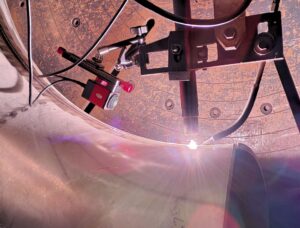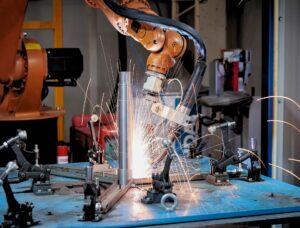Welding distortion is a common challenge that affects weld quality, leading to misalignment, warping, and structural weaknesses. Metal expands and contracts due to heat input, causing unwanted movement in the workpiece. Whether you’re working on MIG welding, TIG welding, or metal arc welding, controlling distortion is essential for precision and durability. Using weld monitoring cameras and welding inspection techniques can help detect early signs of distortion and improve welding quality. In this guide, we’ll explore key methods like preheating, clamping, and stitch welding to help keep your workpiece straight.
What Causes Welding Distortion?
Welding distortion occurs due to uneven thermal expansion and contraction during the welding process. Some key factors include:
- Excessive Heat Input – Too much heat causes metal to expand and shrink unevenly.
- Incorrect Welding Sequence – Welding in the wrong order can create stress imbalances.
- Thin or Large Workpieces – Thin sheets warp more easily, and larger structures experience more thermal expansion.
- Improper Fixturing – Lack of clamping or restraints allows movement during welding.
- Rapid Cooling – Sudden cooling can cause shrinkage and deformation.
A weld monitoring system helps detect distortion risks early by providing real-time arc welding images.
How to Prevent Welding Distortion
1. Preheat the Workpiece
- Why? Preheating reduces the temperature difference between the welding arc and base metal, minimizing expansion and contraction stresses.
- How? Use a welding equipment preheater to raise the metal temperature before welding.
- Best for: TIG welding, MIG welding, and plasma arc welding, especially for thick materials.
Welding visual inspection techniques help ensure proper preheating.
2. Use Proper Clamping and Fixturing
- Secure the workpiece using clamps, jigs, and fixtures to hold it in place.
- Apply restraining forces evenly to prevent unwanted movement.
- For large structures, use temporary tacks before final welding.
Welding inspection techniques help confirm alignment before and after welding.
3. Apply the Stitch Welding Method
- Instead of continuous welds, use short intermittent welds to minimize heat input.
- Space out welds evenly to distribute thermal expansion forces.
- Best for thin sheet metals and precision welding applications.
A weld monitoring system helps optimize stitch welding patterns for minimal distortion.
4. Follow the Right Welding Sequence
- Weld from the center outward to balance stress across the workpiece.
- Use a backstep welding technique (welding in reverse segments) to counteract distortion forces.
- Plan your welding order to prevent unnecessary shrinkage.
A welding camera provides arc welding images to track welding sequences accurately.
5. Reduce Heat Input with Proper Settings
- Lowering voltage and amperage helps control distortion, especially in MIG and TIG welding.
- Adjust travel speed to prevent excessive heat buildup.
- Optimize wire feed speed in the MIG and MAG welding process.
Welding inspection cameras help monitor heat input and fine-tune settings in real time.
6. Use Controlled Cooling Methods
- Avoid rapid cooling; let the metal cool naturally to reduce shrinkage stresses.
- For thick materials, apply post-weld heat treatment to balance internal stresses.
- Use a welding blanket to slow cooling and prevent cracking.
Welding technology like infrared weld monitoring cameras can track cooling rates efficiently.
How Weld Monitoring Systems Help Prevent Welding Distortion
A weld monitoring system plays a crucial role in preventing welding distortion by offering:
- Real-time Arc Welding Image Analysis – Monitors metal movement and temperature distribution.
- Welding Visual Inspection – Detects misalignment and ensures weld quality.
- Process Optimization – Helps adjust heat input, travel speed, and sequence for minimal distortion.
Using a welding camera manufacturer’s system helps improve precision and minimize rework.
Conclusion: Achieve Precision with Proper Distortion Control
Controlling welding distortion is essential for achieving strong, straight, and high-quality welds. By using preheating, clamping, stitch welding, proper welding sequences, and controlled cooling, you can prevent warping and misalignment in your projects.
Advanced weld monitoring systems and welding inspection techniques provide real-time feedback to improve efficiency and reduce errors.
Mecaweld’s welding cameras and inspection tools ensure better weld monitoring and quality control. Contact us today to learn how our solutions can help you achieve distortion-free welding results!



